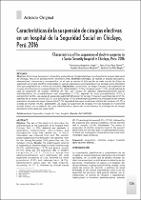| dc.contributor.author | Fernández Mogollón, Jorge Luis | |
| dc.contributor.author | Santa Cruz-Ruiz, Diana | |
| dc.contributor.author | Zapata-Velezmoro, Roberto | |
| dc.contributor.author | Santa Cruz-Polo, Roger | |
| dc.date.accessioned | 2023-06-09T17:45:36Z | |
| dc.date.available | 2023-06-09T17:45:36Z | |
| dc.date.issued | 2018-08-12 | |
| dc.identifier.citation | Revista del Cuerpo Médico Hospital Nacional Almanzor Aguinaga Asenjo. 2017; 10(3). | es_PE |
| dc.identifier.uri | https://hdl.handle.net/20.500.12959/3874 | |
| dc.description.abstract | Objetivo: Determinar las características de la suspensión de cirugías electivas en un hospital de la seguridad social de Chiclayo, Perú en el periodo enero- diciembre 2016. Material y métodos: Se realizó un estudio descriptivo, observacional, transversal y retrospectivo, en el cual se recolectó información de cada una de las fichas de suspensión de cirugía electiva encontradas en sala de operaciones correspondientes al periodo enero-diciembre 2016 que cumplieron los criterios de inclusión. Resultados: Los servicios con mayor frecuencia de suspensión de cirugías electivas fueron: traumatología (16,3%), oftalmología (13,7%) y cirugía general (11,9%), siendo además la tasa de suspensión de cirugías electivas del 10%. Las cirugías de catarata (facoemulsificación) fueron individualmente los procedimientos más suspendidos (13,2%), seguidos de otros procedimientos (9,2%) y osteosíntesis (6,9%). Las causas de suspensión administrativas fueron las más frecuentes constituyendo el 57,1%, seguidos de las causas clínicas (23,7%) y las quirúrgicas (8,5%); siendo específicamente la prolongación del tiempo operatorio la causa con mayor frecuencia (27,3%), seguida de las malas condiciones clínicas del paciente (13,7%) y la falta de insumos (10,5%). Conclusión: Las causas de suspensión de cirugías electivas halladas en el presente estudio fueron, en su mayoría, de causa administrativa, dentro de la cual destaca la prolongación de tiempo operatorio como causa más importante. | es_PE |
| dc.description.abstract | Objetive: The aim of this study is to determine the
characteristics of the suspension of an hospital from
Chiclayo, Perú. in 2016. Material and methods: A
descriptive, observational, cross-sectional and
retrospective study was carried out, in which
information was collected from each The elective
surgery suspension records found in the operating room
for the January-December 2016 period that met the
inclusion criteria. Results: The most frequent services
of suspension of elective surgeries were: traumatology
(16.3%), ophthalmology (13.7%) and general surgery
(11.9%), being also the suspension rate of elective
s u r g e r i e s o f 1 0 % . C a t a r a c t s u r g e r i e s
(phacoemulsification) were individually the most
suspended procedures (13.2%), followed by other
procedures (9.2%) and osteosynthesis (6.9%).
Administrative causes were the most frequent,
accounting for 57.1%, followed by clinical causes
(23.7%) and surgical causes (8.5%); (27.3%), followed by
the patient's poor clinical conditions (13.7%) and the
lack of supplies (10.5%). Conclusion: The causes of
suspension of elective surgeries found in the present
study were, for the most part, an administrative cause,
in which the prolongation of operative time as the most
important cause stands out. | es_PE |
| dc.format | application/pdf | es_PE |
| dc.language.iso | spa | es_PE |
| dc.publisher | Seguro Social de Salud (EsSalud) | es_PE |
| dc.relation.uri | http://cmhnaaa.org.pe/ojs/index.php/rcmhnaaa/article/view/3 | es_PE |
| dc.rights | info:eu-repo/semantics/openAccess | es_PE |
| dc.rights.uri | https://creativecommons.org/licenses/by-nc-sa/4.0/ | es_PE |
| dc.subject | Suspensión | es_PE |
| dc.subject | Cirugía electiva | es_PE |
| dc.subject | Hospital | es_PE |
| dc.subject | Elective surgery | es_PE |
| dc.title | Características de la suspensión de cirugías electivas en un hospital de la Seguridad Social en Chiclayo, Perú. 2016 | es_PE |
| dc.title.alternative | Characteristics of the suspension of elective surgeries in a Social Security hospital in Chiclayo, Peru. 2016 | es_PE |
| dc.type | info:eu-repo/semantics/article | es_PE |
| dc.subject.ocde | https://purl.org/pe-repo/ocde/ford#3.02.11 | es_PE |
| dc.identifier.doi | https://doi.org/10.35434/rcmhnaaa.2017.103.3 | |






